TPMS Abarth 124 Spider 2017 Owner handbook (in English)
[x] Cancel search | Manufacturer: ABARTH, Model Year: 2017, Model line: 124 Spider, Model: Abarth 124 Spider 2017Pages: 220, PDF Size: 2.9 MB
Page 10 of 220
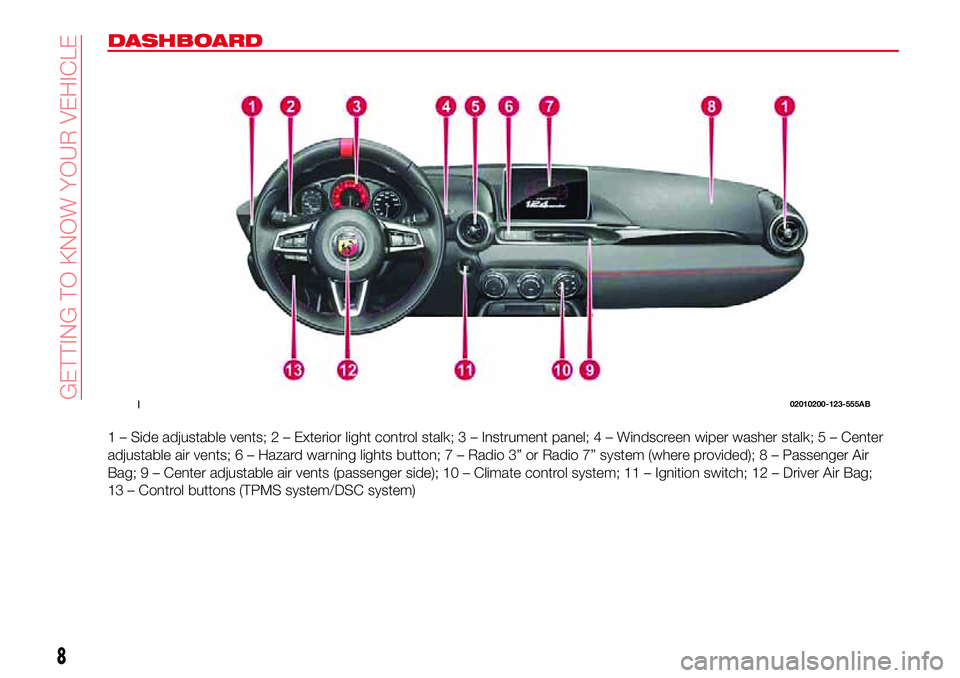
DASHBOARD
1–Sideadjustablevents;2–Exterior light control stalk;3–Instrument panel;4–Windscreenwiperwasherstalk;5–Center
adjustable air vents; 6 – Hazard warning lights button; 7 – Radio 3” or Radio 7” system (where provided); 8 – Passenger Air
Bag;9–Centeradjustable air vents (passenger side); 10 – Climate control system; 11 – Ignition switch; 12 – Driver Air Bag;
13 – Control buttons (TPMS system/DSC system)
102010200-123-555AB
8
GETTING TO KNOW YOUR VEHICLE
Page 61 of 220
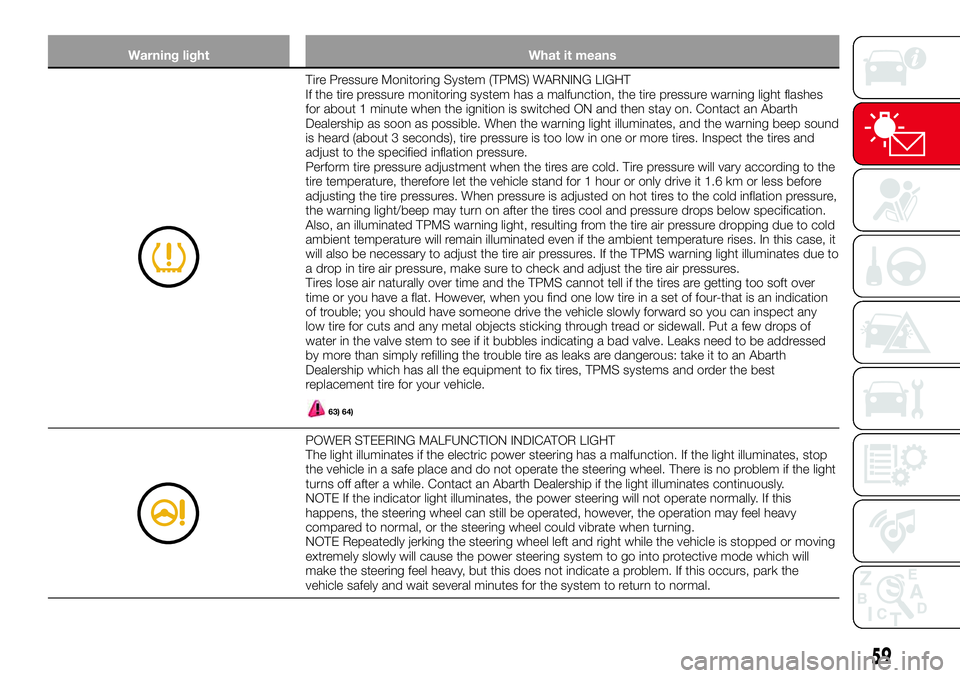
Warning light What it means
Tire Pressure Monitoring System (TPMS) WARNING LIGHT
If the tire pressure monitoring system has a malfunction, the tire pressure warning light flashes
for about 1 minute when the ignition is switched ON and then stay on. Contact an Abarth
Dealership as soon as possible. When the warning light illuminates, and the warning beep sound
is heard (about 3 seconds), tire pressure is too low in one or more tires. Inspect the tires and
adjust to the specified inflation pressure.
Perform tire pressure adjustment when the tires are cold. Tire pressure will vary according to the
tire temperature, therefore let the vehicle stand for 1 hour or only drive it 1.6 km or less before
adjusting the tire pressures. When pressure is adjusted on hot tires to the cold inflation pressure,
the warning light/beep may turn on after the tires cool and pressure drops below specification.
Also, an illuminated TPMS warning light, resulting from the tire air pressure dropping due to cold
ambient temperature will remain illuminated even if the ambient temperature rises. In this case, it
will also be necessary to adjust the tire air pressures. If the TPMS warning light illuminates due to
a drop in tire air pressure, make sure to check and adjust the tire air pressures.
Tires lose air naturally over time and the TPMS cannot tell if the tires are getting too soft over
time or you have a flat. However, when you find one low tire in a set of four-that is an indication
of trouble; you should have someone drive the vehicle slowly forward so you can inspect any
low tire for cuts and any metal objects sticking through tread or sidewall. Put a few drops of
water in the valve stem to see if it bubbles indicating a bad valve. Leaks need to be addressed
by more than simply refilling the trouble tire as leaks are dangerous: take it to an Abarth
Dealership which has all the equipment to fix tires, TPMS systems and order the best
replacement tire for your vehicle.
63) 64)
POWER STEERING MALFUNCTION INDICATOR LIGHT
The light illuminates if the electric power steering has a malfunction. If the light illuminates, stop
the vehicle in a safe place and do not operate the steering wheel. There is no problem if the light
turns off after a while. Contact an Abarth Dealership if the light illuminates continuously.
NOTE If the indicator light illuminates, the power steering will not operate normally. If this
happens, the steering wheel can still be operated, however, the operation may feel heavy
compared to normal, or the steering wheel could vibrate when turning.
NOTE Repeatedly jerking the steering wheel left and right while the vehicle is stopped or moving
extremely slowly will cause the power steering system to go into protective mode which will
make the steering feel heavy, but this does not indicate a problem. If this occurs, park the
vehicle safely and wait several minutes for the system to return to normal.
59
Page 68 of 220
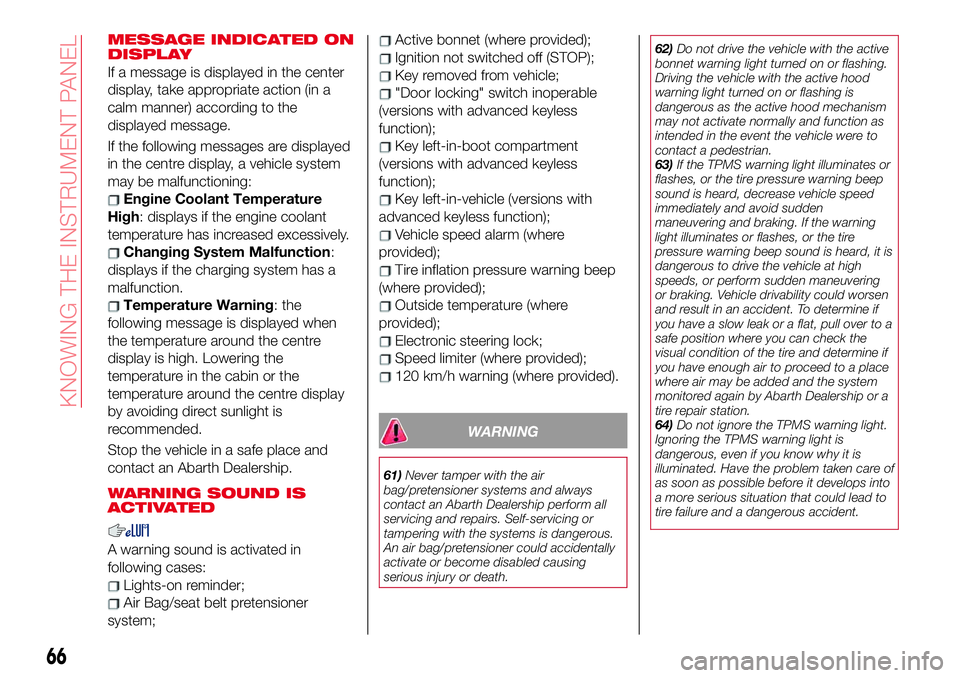
MESSAGE INDICATED ON
DISPLAY
If a message is displayed in the center
display, take appropriate action (in a
calm manner) according to the
displayed message.
If the following messages are displayed
in the centre display, a vehicle system
may be malfunctioning:
Engine Coolant Temperature
High: displays if the engine coolant
temperature has increased excessively.
Changing System Malfunction:
displays if the charging system has a
malfunction.
Temperature Warning:the
following message is displayed when
the temperature around the centre
display is high. Lowering the
temperature in the cabin or the
temperature around the centre display
by avoiding direct sunlight is
recommended.
Stop the vehicle in a safe place and
contact an Abarth Dealership.
WARNING SOUND IS
ACTIVATED
A warning sound is activated in
following cases:
Lights-on reminder;
Air Bag/seat belt pretensioner
system;
Active bonnet (where provided);
Ignition not switched off (STOP);
Key removed from vehicle;
"Door locking" switch inoperable
(versions with advanced keyless
function);
Key left-in-boot compartment
(versions with advanced keyless
function);
Key left-in-vehicle (versions with
advanced keyless function);
Vehicle speed alarm (where
provided);
Tire inflation pressure warning beep
(where provided);
Outside temperature (where
provided);
Electronic steering lock;
Speed limiter (where provided);
120 km/h warning (where provided).
WARNING
61)Never tamper with the air
bag/pretensioner systems and always
contact an Abarth Dealership perform all
servicing and repairs. Self-servicing or
tampering with the systems is dangerous.
An air bag/pretensioner could accidentally
activate or become disabled causing
serious injury or death.62)Do not drive the vehicle with the active
bonnet warning light turned on or flashing.
Driving the vehicle with the active hood
warning light turned on or flashing is
dangerous as the active hood mechanism
may not activate normally and function as
intended in the event the vehicle were to
contact a pedestrian.
63)If the TPMS warning light illuminates or
flashes, or the tire pressure warning beep
sound is heard, decrease vehicle speed
immediately and avoid sudden
maneuvering and braking. If the warning
light illuminates or flashes, or the tire
pressure warning beep sound is heard, it is
dangerous to drive the vehicle at high
speeds, or perform sudden maneuvering
or braking. Vehicle drivability could worsen
andresultinanaccident.Todetermineif
you have a slow leak or a flat, pull over to a
safe position where you can check the
visual condition of the tire and determine if
you have enough air to proceed to a place
where air may be added and the system
monitored again by Abarth Dealership or a
tire repair station.
64)Do not ignore the TPMS warning light.
Ignoring the TPMS warning light is
dangerous, even if you know why it is
illuminated. Have the problem taken care of
as soon as possible before it develops into
a more serious situation that could lead to
tire failure and a dangerous accident.
66
KNOWING THE INSTRUMENT PANEL
Page 74 of 220

74)The capability of the DSC system must
never be tested irresponsibly and
dangerously, in such a way as to
compromise personal safety and the safety
of others.
75)If the active bonnet has activated,
always contact an Abarth Dealership. If the
bonnet release handle is pulled after the
active bonnet has activated, the bonnet will
rise even further. If the vehicle is driven with
the bonnet raised it will obstruct visibility
and could result in an accident. In addition,
do not attempt to push the bonnet back
down. Otherwise, it could deform the
bonnet or cause injury because the
activated bonnet cannot be lowered
manually. Before driving the vehicle contact
an Abarth Dealership after the active
bonnet has activated, make sure that the
raised bonnet does not obstruct vision and
drive the vehicle at a low speed.AUXILIARY DRIVING
SYSTEMS
TPMS (Tire Pressure
Monitoring System)
76) 77) 78)
The Tire Pressure Monitoring System
(TPMS) monitors the pressure for each
tire. If tire pressure is too low in one or
more tires, the system will inform the
driver via the warning light in the
instrument cluster and by the warning
beep sound. Refer to “Warning lights
and messages” paragraph “Knowing
the instrument panel” chapter.
Refer to “Tire inflation pressure warning
beep” in “Warning sound is activated” in
Knowing the instrument panel” chapter.
The tire pressure sensors installed on
each wheel send tire pressure data by
radio signal to the receiver unit in the
vehicle.
NOTE When the ambient temperature is
low due to seasonal changes, tire
temperatures are also lower. When the
tire temperature decreases, the air
pressure decreases as well. The TPMS
warning light may illuminate more
frequently. Visually inspect the tires daily
before driving, and check tire pressures
monthly with a tire pressure gauge.
When checking tire pressures, use of adigital tire pressure gauge is
recommended.
TPMS does not alleviate your need to
check the pressure and condition of all
four tires regularly.IMPORTANT Each tire, including the
spare (where provided), should be
checked monthly when cold and
inflated to the inflation pressure
recommended by the vehicle
manufacturer on the vehicle placard or
tire inflation pressure label (if your
vehicle has tires of a different size than
the size indicated on the vehicle placard
or tire inflation pressure label, you
should determine the proper tire
inflation pressure for those tires).
IMPORTANT As an added safety
feature, your vehicle has been equipped
with a TMPS system that illuminates a
low tire pressure telltale when one or
more of your tires is significantly
under-inflated. Accordingly, when the
low tire pressure telltale illuminates, you
should stop and check your tires as
soon as possible, and inflate them to
the proper pressure. Driving on a
significantly under-inflated tire causes
the tire to overheat and can lead to tire
failure. Under-inflation also reduces fuel
efficiency and tire tread life, and may
affect the vehicle's handling and
stopping ability.
72
SAFETY
Page 75 of 220
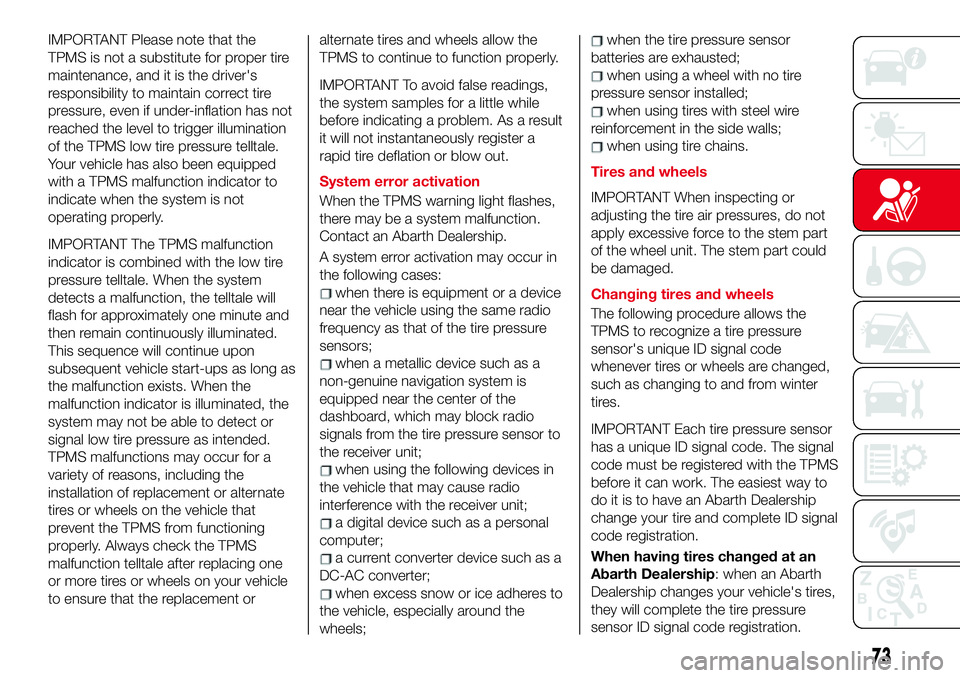
IMPORTANT Please note that the
TPMS is not a substitute for proper tire
maintenance, and it is the driver's
responsibility to maintain correct tire
pressure, even if under-inflation has not
reached the level to trigger illumination
of the TPMS low tire pressure telltale.
Your vehicle has also been equipped
with a TPMS malfunction indicator to
indicate when the system is not
operating properly.
IMPORTANT The TPMS malfunction
indicator is combined with the low tire
pressure telltale. When the system
detects a malfunction, the telltale will
flash for approximately one minute and
then remain continuously illuminated.
This sequence will continue upon
subsequent vehicle start-ups as long as
the malfunction exists. When the
malfunction indicator is illuminated, the
system may not be able to detect or
signal low tire pressure as intended.
TPMS malfunctions may occur for a
variety of reasons, including the
installation of replacement or alternate
tires or wheels on the vehicle that
prevent the TPMS from functioning
properly. Always check the TPMS
malfunction telltale after replacing one
or more tires or wheels on your vehicle
to ensure that the replacement oralternate tires and wheels allow the
TPMS to continue to function properly.
IMPORTANT To avoid false readings,
the system samples for a little while
before indicating a problem. As a result
it will not instantaneously register a
rapid tire deflation or blow out.
System error activation
When the TPMS warning light flashes,
there may be a system malfunction.
Contact an Abarth Dealership.
A system error activation may occur in
the following cases:
when there is equipment or a device
near the vehicle using the same radio
frequency as that of the tire pressure
sensors;
when a metallic device such as a
non-genuine navigation system is
equipped near the center of the
dashboard, which may block radio
signals from the tire pressure sensor to
the receiver unit;
when using the following devices in
the vehicle that may cause radio
interference with the receiver unit;
a digital device such as a personal
computer;
a current converter device such as a
DC-AC converter;
when excess snow or ice adheres to
the vehicle, especially around the
wheels;
when the tire pressure sensor
batteries are exhausted;
when using a wheel with no tire
pressure sensor installed;
when using tires with steel wire
reinforcement in the side walls;
when using tire chains.
Tires and wheels
IMPORTANT When inspecting or
adjusting the tire air pressures, do not
apply excessive force to the stem part
of the wheel unit. The stem part could
be damaged.
Changing tires and wheels
The following procedure allows the
TPMS to recognize a tire pressure
sensor's unique ID signal code
whenever tires or wheels are changed,
such as changing to and from winter
tires.
IMPORTANT Each tire pressure sensor
has a unique ID signal code. The signal
code must be registered with the TPMS
before it can work. The easiest way to
do it is to have an Abarth Dealership
change your tire and complete ID signal
code registration.
When having tires changed at an
Abarth Dealership: when an Abarth
Dealership changes your vehicle's tires,
they will complete the tire pressure
sensor ID signal code registration.
73
Page 76 of 220

When changing tires yourself:ifyou
or someone else changes tires, you or
someone else can also undertake the
steps for the TPMS to complete the ID
signal code registration:
after tires have been changed, switch
the ignition ON, then back to ACC or
OFF;
wait for about 15 minutes;
after about 15 minutes, drive the
vehicle at a speed of at least 25 km/h
for 10 minutes and the tire pressure
sensor ID signal code will be registered
automatically.
IMPORTANT If the vehicle is driven
within about 15 minutes of changing
tires, the
warning light will flash
because the sensor ID signal code
would not have been registered. If this
happens, park the vehicle for about
15 minutes, after which the sensor ID
signal code will register upon driving the
vehicle for 10 minutes.
Replacing tires and wheels
IMPORTANT When replacing/repairing
the tires or wheels or both, have the
work done by an Abarth Dealership, or
the tire pressure sensors may be
damaged.
IMPORTANT The wheels equipped on
your vehicle are specially designed for
installation of the tire pressure sensors.Do not use non-genuine wheels,
otherwise it may not be possible to
install the tire pressure sensors.
Be sure to have the tire pressure
sensors installed whenever tires or
wheels are replaced.
When having a tire or wheel or both
replaced, the following types of tire
pressure sensor installations are
possible:
the tire pressure sensor is removed
from the old wheel and installed to the
new one;
the same tire pressure sensor is used
with the same wheel. Only the tire is
replaced;
a new tire pressure sensor is installed
to a new wheel.
IMPORTANT The tire pressure sensor
ID signal code must be registered when
a new tire pressure sensor is
purchased. For purchase of a tire
pressure sensor and registration of the
tire pressure sensor ID signal code,
consult an Abarth Dealership.
IMPORTANT When reinstalling a
previously removed tire pressure sensor
to a wheel, replace the grommet (seal
between valve body/sensor and wheel)
for the tire pressure sensor.MECHANICAL LIMITED
SLIP DIFFERENTIAL
Your vehicle is equipped with a
mechanical limited slip differential. In
particular this vehicle adopts a
super-LSD which guarantees improved
vehicle traction and handling.
A super-LSD with a low torque bias
ratio (*) has been adopted to improve
performance when starting from a
standstill, driving straight-ahead and
response.
(*)Torque bias ratio: when a wheel
slips due to a low-traction surface, the
LSD provides proportionally more
torque to the opposite wheel. The
torque bias ratio is the ratio of torque
supplied to the right and left wheels in
such cases, and represents the
performance capability of the LSD.
The super-LSD is a torque-sensing type
that provides improved driving stability
due to the following characteristics:
low torque bias ratio provides
improved controllability (torque bias
ratio: 2.0);
creation of initial torque provides
improved starting from a standstill and
acceleration/deceleration response, and
driving straight-ahead (initial torque:
49 Nm);
simplified construction provides
weight reduction.
74
SAFETY
Page 78 of 220
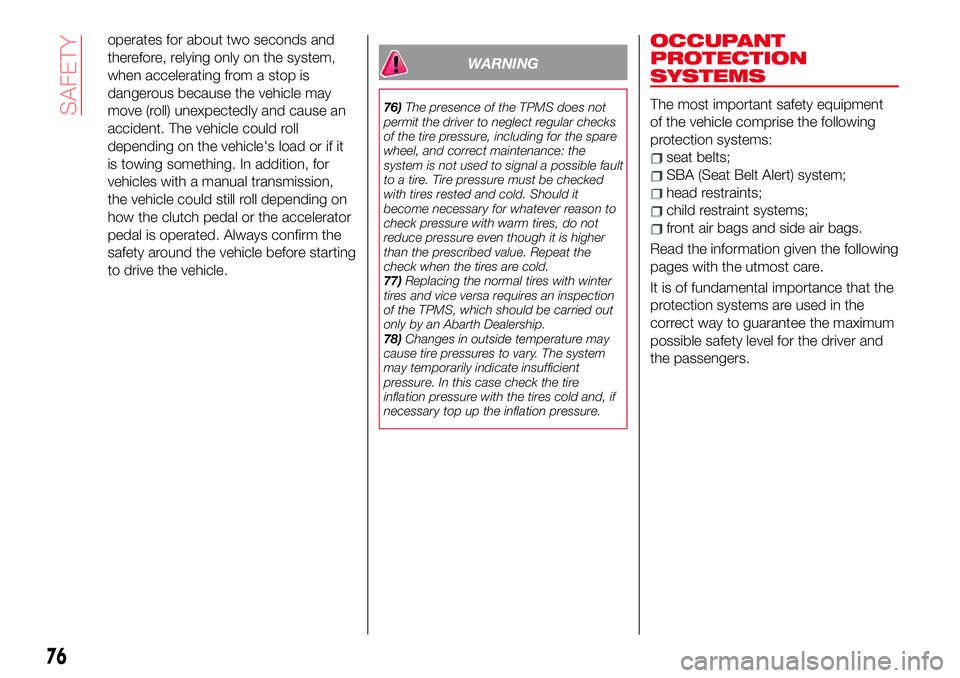
operates for about two seconds and
therefore, relying only on the system,
when accelerating from a stop is
dangerous because the vehicle may
move (roll) unexpectedly and cause an
accident. The vehicle could roll
depending on the vehicle's load or if it
is towing something. In addition, for
vehicles with a manual transmission,
the vehicle could still roll depending on
how the clutch pedal or the accelerator
pedal is operated. Always confirm the
safety around the vehicle before starting
to drive the vehicle.
WARNING
76)The presence of the TPMS does not
permit the driver to neglect regular checks
of the tire pressure, including for the spare
wheel, and correct maintenance: the
system is not used to signal a possible fault
to a tire. Tire pressure must be checked
with tires rested and cold. Should it
become necessary for whatever reason to
check pressure with warm tires, do not
reduce pressure even though it is higher
than the prescribed value. Repeat the
check when the tires are cold.
77)Replacing the normal tires with winter
tires and vice versa requires an inspection
of the TPMS, which should be carried out
only by an Abarth Dealership.
78)Changes in outside temperature may
cause tire pressures to vary. The system
may temporarily indicate insufficient
pressure. In this case check the tire
inflation pressure with the tires cold and, if
necessary top up the inflation pressure.
OCCUPANT
PROTECTION
SYSTEMS
The most important safety equipment
of the vehicle comprise the following
protection systems:
seat belts;
SBA (Seat Belt Alert) system;
head restraints;
child restraint systems;
front air bags and side air bags.
Read the information given the following
pages with the utmost care.
It is of fundamental importance that the
protection systems are used in the
correct way to guarantee the maximum
possible safety level for the driver and
the passengers.
76
SAFETY
Page 216 of 220

Jump starting..............153
Jump starting (procedure).......154
Key battery replacement........10
Keyless Entry System...........9
Keys......................9
Lane change signals...........27
Load limiter (pretensioner)........80
Maintaining the finish.........173
Manual climate control system.....32
Manual transmission..........112
Mechanical Limited Slip
Differential................74
Message indicated on display.....66
Mirrors....................22
Multimedia.................190
Navigation................202
Occupant protection systems.....76
Odometer/Trip meter...........49
Outside mirrors...............22
Owner maintenance precautions . . .159
Paintwork (preserving).........172
Parking...................110
Parking brake...............111
Parking Sensor System.........123
Passenger Air Bag............96
Passenger occupant classification
system.................101
Passive Entry................17
Performance...............186Periodic checks (scheduled
servicing)................160
Powermirrors ...............23
Power window lock switch.......37
Power windows..............36
Prescriptions for handling the
vehicle at the end of its life.....189
Pretensioners................80
Push button start positions.......11
Radio 3”.................192
Radio 7”..................197
Read this carefully..............2
Rear camera (ParkView rear
backup camera)...........127
Rear fog lights...............26
Refuelling procedure..........125
Refuelling the vehicle..........125
Replacing a bulb.............133
Replacing a tire..............170
Replacing exterior light bulbs.....136
Replacing fuses.............141
Rimsandtires ..............179
Rims and tires provided........180
SBA system (Seat Belt Alert)......79
Scheduled servicing plan.......161
Seat belt precautions...........77
Seat belt pretensioner and load
limiting systems.............80
Seat Belt pretensioners.........96
Seat belts..................77Seat belts (fastening/unfastening)}.......................77
Seats.....................19
Seats (manual adjustment).......19
Seats and fabric parts (cleaning) . . .174
Shift-lock override (automatic
gearbox)................114
Shift-lock system (automatic
gearbox)................114
Side Air Bags................96
Snow chains...............171
Speed limiter...............120
SPORTmode...............116
Starting the engine.........11,110
Steering wheel...............21
Supplementary restraint system
(SRS)-Airbag .............94
Symbols....................3
TCS (Traction Control System).....68
Theft deterrent system..........15
Tips, controls and general
information...............191
Tire service kit..............148
Tires rotation (recommendations) . .171
Tool storage................148
Towing the vehicle............155
Towing trailers..............130
TPMS (Tire Pressure Monitoring
System)..................72
Turn signals.................27
Turning the engine off...........13
INDEX